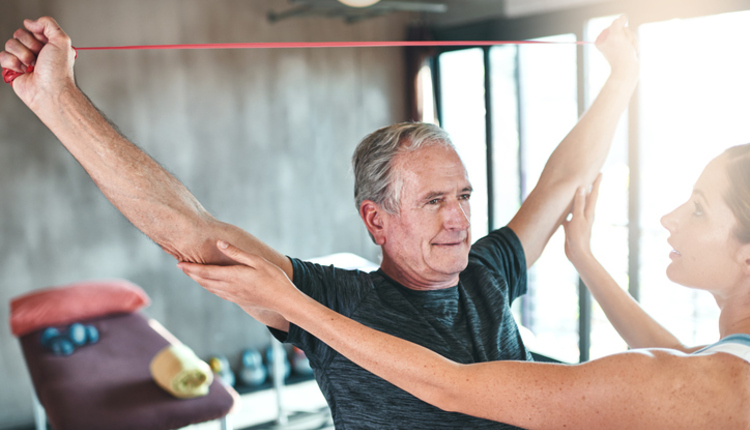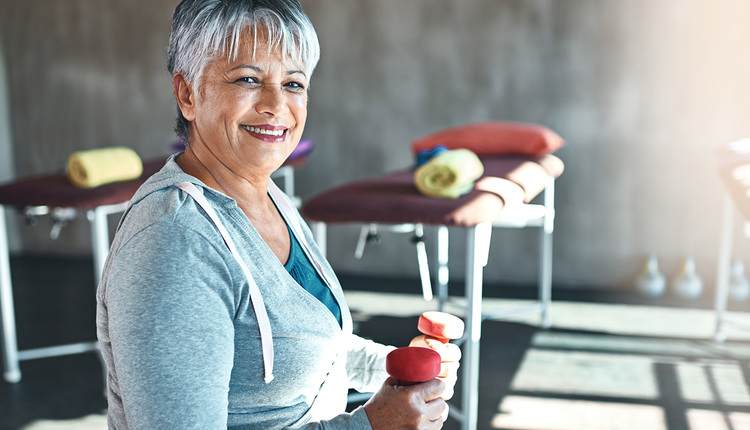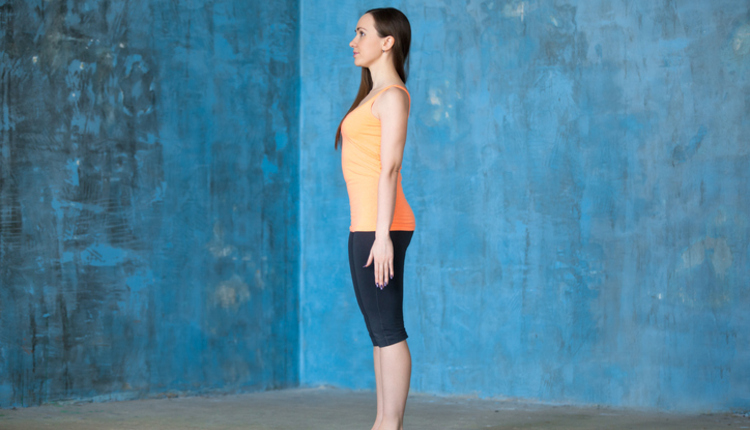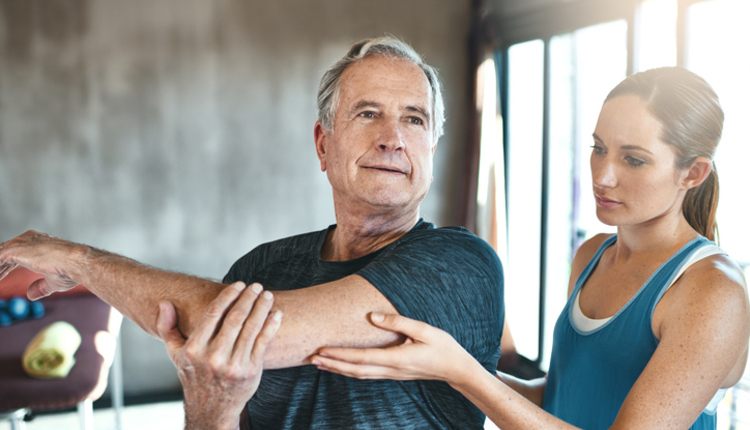
If you have a client with osteoporosis or osteopenia you should understand this disease in order to teach them how to exercise properly and safely in order to decrease the risk of the progression of this disease. According to the National Osteoporosis Foundation, half of all women and 1 out of 4 men over 50 will have a wrist, hip, or spine fracture due to osteoporosis. Effective and safe exercise can improve their quality of life, overall health and keep osteoporosis under control.
Studies have shown that exercise can reduce the risk of osteoporosis. This is because when the muscle pulls on the bone the bone mass increases. There is evidence demonstrating that exercise can slow loss of bone density and that osteoporosis is typically less prevalent in people who are active. Exercise may also prevent osteopenia from becoming osteoporosis.
It is a good idea to start building bone mass at a young age so that your clients will start with a higher level bone mass as they age. The activity of bone-forming cells begins to decrease at age 35. Weight-bearing exercises are the best exercise for increasing bone density; this type of exercise not only will strengthen bones, it will also keep your clients' hearts healthy and muscles strong and help with weight control.
Understanding osteoporosis and its pathology is needed in order to create safe and effective programming. After medical clearance, someone with osteoporosis can begin to exercise. As with any workout routine, warm-up before starting and cool-down afterwards is important. Teach your clients to use proper body mechanics during the exercise session and throughout the day. The body needs to always be aligned properly so there is less stress on the spine to help them to maintain good posture, which also helps reduce kyphosis. This forward head and upper back curve can be noticed in those with osteoporosis, sometimes caused by small fractures in the spine.
An effective exercise program includes aerobic (weight-bearing), strength training, posture and balance exercise. Weight bearing exercise is where the weight of the body is transmitted through the bones. Walking, dancing and hiking are examples of weight bearing exercise. This should be done three to five times a week for 45 minutes. If using a treadmill, hold on to the handle. A recumbent bicycle is ideal because its use eliminates the risk of falling. Do not do high impact exercise, which can cause a fracture. Swimming and water exercise, although good for the heart, is not as effective for bone density.
Strength training or resistance exercise generates muscle tension on the bone. We start our clients with a light weight performing one set of 10 repetitions. Then we gradually increase to two sets, and add weight slowly. Strength training should be done two to three times per week without working the same muscle group two days in a row. Improving muscle strength will also help improve balance.
It is important to focus on exercise designed to treat osteoporosis by strengthening bones and muscles leading to better posture and balance. Strength training actually stimulates the bone because the muscle is pulling on the bone. We lose muscle mass as we age and with less muscle, there is less tugging on the bones. Bones lose density because there is less use or need for density. So not only does strength training increase our muscle mass, which has numerous benefits, but also stimulates the bones. Exercising while standing is more effective and can help with balance as well.
Balance exercises are also crucial for this population. It is important to work on balance in order to prevent falls. Falling and fear of falling is a serious problem for someone with osteoporosis. You should instruct your clients to always wear the proper footwear and balance exercises should be performed daily and simply practicing standing on one leg for ten seconds will help and can be done anywhere. It is important to keep the major muscle groups of the legs and core strong, which will also help their balance. Due to a fear a falling some people become inactive which only accelerates loss of bone mass.
Postural exercise is also important. A goal is to decrease the risk of rounded shoulders and spinal fractures. Emphasize body awareness and alignment during exercise and activities of daily living. Posture exercises help maintain proper body alignment and can be performed a few times a day. You should show your clients how to be mindful of their posture throughout the day. A good stretching program will help. Focus on stretching the chest muscles and strengthen the back muscles to prevent rounded shoulders. Keeping muscles strong and flexible will also help with an emphasis on spinal stability.
All fitness professionals need to learn about the precautions to take for clients with osteoporosis. Your client may know their lumber spine DEXA numbers - they are not given a test (DEXA) for the thoracic spine. The same caution needs to be taken for the thoracic spine as well. Bending forward from the waist, side bending and rotation is contraindicated. Your client needs to be very clear on this before they begin to exercise. Therefore, doing something as simple as reaching for the toes can be harmful. If they have to bend forward they must keep the back straight, hinging from the hips, without rounding the back.
As a fitness professional, you need to teach your client how to move in ways which will avoid compression fractures. Movement that involves forward bending or rounding the spine has been found to increase spinal fractures in this population. Since an abdominal crunch and other traditional abdominal exercises and some abdominal machines are contraindicated, it is necessary to do other abdominal exercises that do not have forward flexion. With that in mind it is important to know what exercises are safe to strengthen the core if bone mass is low. Some examples of exercises that are safe are the dead bug, pelvic tilt, and leg raises.
Extreme twisting of the trunk is also contraindicated. A large percentage of Pilates and Yoga exercises have to be modified in order to avoid bending, twisting and forward bending with rotation. Pilates exercises done in flexion can be modified. For example, you can do the hundred, double leg stretch and the criss-cross with your head on the floor. There are still several Pilates exercises that can be done such as single leg circles and the corkscrew; back extension exercises such as swimming are also fine. Spinal extension exercises should be performed because it has been found that those with stronger back muscles have higher spine bone density. The posterior of the vertebra contain cortical bone, which is strong. Therefore, back extension is safe. Sports in which your client participates also needs to be examined. For example, a golf swing might create too much force for the spine and might have to be modified.
A properly designed practice can strengthen the skeleton and improve balance thereby decreasing the risk of future falls. It can also improve posture and rounding of the back. As a fitness professional you will be helping your client by teaching them about strength training, posture and balance, and to be mindful of their condition during their daily activities.
READ PART 1
Studies have shown that exercise can reduce the risk of osteoporosis. This is because when the muscle pulls on the bone the bone mass increases. There is evidence demonstrating that exercise can slow loss of bone density and that osteoporosis is typically less prevalent in people who are active. Exercise may also prevent osteopenia from becoming osteoporosis.
It is a good idea to start building bone mass at a young age so that your clients will start with a higher level bone mass as they age. The activity of bone-forming cells begins to decrease at age 35. Weight-bearing exercises are the best exercise for increasing bone density; this type of exercise not only will strengthen bones, it will also keep your clients' hearts healthy and muscles strong and help with weight control.
Understanding osteoporosis and its pathology is needed in order to create safe and effective programming. After medical clearance, someone with osteoporosis can begin to exercise. As with any workout routine, warm-up before starting and cool-down afterwards is important. Teach your clients to use proper body mechanics during the exercise session and throughout the day. The body needs to always be aligned properly so there is less stress on the spine to help them to maintain good posture, which also helps reduce kyphosis. This forward head and upper back curve can be noticed in those with osteoporosis, sometimes caused by small fractures in the spine.
An effective exercise program includes aerobic (weight-bearing), strength training, posture and balance exercise. Weight bearing exercise is where the weight of the body is transmitted through the bones. Walking, dancing and hiking are examples of weight bearing exercise. This should be done three to five times a week for 45 minutes. If using a treadmill, hold on to the handle. A recumbent bicycle is ideal because its use eliminates the risk of falling. Do not do high impact exercise, which can cause a fracture. Swimming and water exercise, although good for the heart, is not as effective for bone density.
Strength training or resistance exercise generates muscle tension on the bone. We start our clients with a light weight performing one set of 10 repetitions. Then we gradually increase to two sets, and add weight slowly. Strength training should be done two to three times per week without working the same muscle group two days in a row. Improving muscle strength will also help improve balance.
It is important to focus on exercise designed to treat osteoporosis by strengthening bones and muscles leading to better posture and balance. Strength training actually stimulates the bone because the muscle is pulling on the bone. We lose muscle mass as we age and with less muscle, there is less tugging on the bones. Bones lose density because there is less use or need for density. So not only does strength training increase our muscle mass, which has numerous benefits, but also stimulates the bones. Exercising while standing is more effective and can help with balance as well.
Balance exercises are also crucial for this population. It is important to work on balance in order to prevent falls. Falling and fear of falling is a serious problem for someone with osteoporosis. You should instruct your clients to always wear the proper footwear and balance exercises should be performed daily and simply practicing standing on one leg for ten seconds will help and can be done anywhere. It is important to keep the major muscle groups of the legs and core strong, which will also help their balance. Due to a fear a falling some people become inactive which only accelerates loss of bone mass.
Postural exercise is also important. A goal is to decrease the risk of rounded shoulders and spinal fractures. Emphasize body awareness and alignment during exercise and activities of daily living. Posture exercises help maintain proper body alignment and can be performed a few times a day. You should show your clients how to be mindful of their posture throughout the day. A good stretching program will help. Focus on stretching the chest muscles and strengthen the back muscles to prevent rounded shoulders. Keeping muscles strong and flexible will also help with an emphasis on spinal stability.
All fitness professionals need to learn about the precautions to take for clients with osteoporosis. Your client may know their lumber spine DEXA numbers - they are not given a test (DEXA) for the thoracic spine. The same caution needs to be taken for the thoracic spine as well. Bending forward from the waist, side bending and rotation is contraindicated. Your client needs to be very clear on this before they begin to exercise. Therefore, doing something as simple as reaching for the toes can be harmful. If they have to bend forward they must keep the back straight, hinging from the hips, without rounding the back.
As a fitness professional, you need to teach your client how to move in ways which will avoid compression fractures. Movement that involves forward bending or rounding the spine has been found to increase spinal fractures in this population. Since an abdominal crunch and other traditional abdominal exercises and some abdominal machines are contraindicated, it is necessary to do other abdominal exercises that do not have forward flexion. With that in mind it is important to know what exercises are safe to strengthen the core if bone mass is low. Some examples of exercises that are safe are the dead bug, pelvic tilt, and leg raises.
Extreme twisting of the trunk is also contraindicated. A large percentage of Pilates and Yoga exercises have to be modified in order to avoid bending, twisting and forward bending with rotation. Pilates exercises done in flexion can be modified. For example, you can do the hundred, double leg stretch and the criss-cross with your head on the floor. There are still several Pilates exercises that can be done such as single leg circles and the corkscrew; back extension exercises such as swimming are also fine. Spinal extension exercises should be performed because it has been found that those with stronger back muscles have higher spine bone density. The posterior of the vertebra contain cortical bone, which is strong. Therefore, back extension is safe. Sports in which your client participates also needs to be examined. For example, a golf swing might create too much force for the spine and might have to be modified.
A properly designed practice can strengthen the skeleton and improve balance thereby decreasing the risk of future falls. It can also improve posture and rounding of the back. As a fitness professional you will be helping your client by teaching them about strength training, posture and balance, and to be mindful of their condition during their daily activities.
READ PART 1















